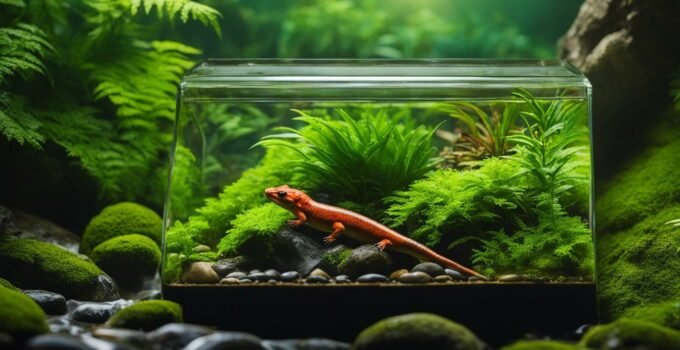If you’re considering getting a salamander as a pet, it’s important to understand the proper care and maintenance they require. Salamanders may seem like low-maintenance pets, but they have specific needs that must be met to ensure their health and well-being.
Key Takeaways:
- Choose the right housing for your salamander by providing an appropriate tank or aquarium with a tight-fitting lid.
- Maintain the proper temperature and lighting to create a healthy environment for your pet salamander.
- Ensure clean and dechlorinated water is available for your salamander to drink or, in the case of aquatic species, swim in.
- Handle your salamander with care, understanding the fragility of their skin and minimizing stress.
- Feed your pet salamander a balanced diet consisting of live prey and appropriate supplements.
- Regularly clean and maintain the salamander’s tank to promote a clean and safe habitat.
- Monitor the health of your salamander, recognizing signs of illness or disease, and seek veterinary care when necessary.
This comprehensive guide will delve into each of these aspects, providing you with valuable information and tips to help you care for your salamander as a pet. By following these guidelines, you will be well-equipped to provide your salamander with a comfortable and nurturing environment, ensuring they thrive in your care.
Choosing the Right Housing for Your Salamander
Creating a suitable living space for your salamander is crucial to their overall well-being and happiness as a pet. When it comes to housing options, there are several factors to consider to ensure that your salamander feels safe and comfortable.
“Remember, the right habitat setup mimics your salamander’s natural environment, promoting their health and allowing them to exhibit natural behaviors.”
Here are some key points to consider when choosing the right housing for your salamander:
| Type of Salamander | Habitat | Key Requirements |
|---|---|---|
| Aquatic | Aquarium with water | Water filtration system, aquatic plants, and floating platforms |
| Semi-Aquatic | Tank with both land and water areas | Ample hiding places, damp substrate, and a shallow water bowl |
| Terrestrial | Tank without water | Variety of hiding places, damp substrate, and a shallow water bowl |
By understanding your salamander’s specific needs and providing a suitable habitat, you can create an environment that promotes their well-being and allows them to thrive. Remember to research the requirements of your salamander species and consult with an expert if needed to ensure you are providing the best possible care.
Maintaining the Proper Temperature and Lighting
Creating a healthy environment for your pet salamander involves maintaining the proper temperature and providing appropriate lighting. Salamanders are ectothermic animals, meaning they rely on external sources to regulate their body temperature. Therefore, it is crucial to provide a temperature range that aligns with their specific needs.
The ideal temperature for most salamander species ranges between 65 to 75 degrees Fahrenheit (18 to 24 degrees Celsius). However, it’s essential to research the specific requirements of your salamander species, as some may have different temperature preferences. To achieve a consistent and suitable temperature, you can use a reptile-specific heating pad or heat lamp. Place the heating source on one side of the tank, creating a temperature gradient and allowing the salamander to regulate its body temperature by moving between warmer and cooler areas.
Proper lighting is also crucial for your salamander’s well-being. While many salamander species are primarily nocturnal, it is still essential to provide them with a simulated day/night cycle. This can be achieved by using a low-wattage UVB bulb or a full-spectrum reptile light. These lights help create a natural photoperiod, stimulate natural behaviors, and promote overall health. However, ensure that the lighting does not produce excessive heat as salamanders prefer cooler temperatures.
Table: Comparison of Temperature and Lighting Needs for Common Salamander Species
| Salamander Species | Ideal Temperature Range (Fahrenheit) | Ideal Lighting |
|---|---|---|
| Tiger Salamander | 68-72 | Low-wattage UVB bulb |
| Fire Salamander | 65-75 | Full-spectrum reptile light |
| Red-backed Salamander | 60-70 | Low-wattage UVB bulb |
When providing lighting, it’s essential to avoid direct sunlight exposure to the salamander’s habitat. Direct sunlight can cause overheating and stress, leading to health problems for your pet. Additionally, monitor the temperature regularly using a reliable thermometer and adjust the heating and lighting setup as needed to maintain a consistent and appropriate environment for your salamander.
Ensuring Clean and Dechlorinated Water
One of the most crucial aspects of caring for a pet salamander is providing clean and dechlorinated water. Salamanders have sensitive skin and can be negatively affected by chemicals found in tap water, such as chlorine. To ensure the health and well-being of your salamander, it is essential to take the necessary steps to provide them with a suitable water source.
The first step is to use a water conditioner to remove chlorine and other harmful substances from tap water. Water conditioners are specifically designed to neutralize these chemicals and make the water safe for your salamander to drink and bathe in. It is important to follow the instructions provided with the water conditioner and use the recommended amount for the volume of water in your salamander’s tank.
In addition to using a water conditioner, it is important to regularly clean and change the water in your salamander’s dish. Salamanders are known to defecate in their water, so it is crucial to keep the water clean to prevent them from ingesting any waste or harmful bacteria. Provide a shallow water dish that is easily accessible for your salamander and clean it at least once a day or as needed.
| Salient Points | Details |
|---|---|
| Salamander Water Dish | Use a shallow water dish that is easily accessible for your salamander to prevent drowning. |
| Water Conditioner | Use a water conditioner designed specifically for removing chlorine and other harmful substances from tap water. |
| Cleaning Frequency | Clean the water dish at least once a day or as needed to prevent waste buildup and harmful bacteria. |
Regularly monitoring the cleanliness and quality of the water in your salamander’s tank is crucial for their overall health. Remember to keep the water dish filled with fresh, dechlorinated water at all times, and observe your salamander for any signs of distress or illness related to their water source.
Proper Handling Techniques for Salamanders
While salamanders are fascinating creatures to observe, it’s essential to handle them with care to avoid causing any harm or stress. Due to their delicate skin, sharp claws, and sensitive respiratory system, improper handling can lead to injuries or health issues for these unique pets. Here are some gentle handling techniques to ensure the well-being of your salamander:
- Wash your hands thoroughly before and after handling your salamander. This helps remove any oils, lotions, or contaminants that could be harmful to their skin or health.
- Use a gentle and calm approach when picking up your salamander. Avoid sudden movements or loud noises that may startle or stress them.
- Support your salamander’s body properly by placing one hand under their belly and the other hand supporting their back legs. This prevents excessive pressure on their delicate body and limbs.
- Keep handling sessions brief and infrequent to minimize stress. Salamanders are sensitive creatures that prefer a quiet and peaceful environment.
“Proper handling is crucial for the well-being of your salamander. By taking a gentle and cautious approach, you can ensure their safety and create a positive bond with your pet.”
Remember, each salamander may have different handling preferences, so it’s essential to observe their behavior and adjust accordingly. Some salamanders may be more comfortable with minimal handling, while others may tolerate short periods of interaction. Always prioritize your salamander’s comfort and well-being above all else.
| Handling Do’s | Handling Don’ts |
|---|---|
|
|
Following these proper handling techniques will help ensure a positive experience for both you and your salamander. By treating them with care and respect, you can enjoy the beauty and wonder of these incredible creatures while keeping them safe and healthy.
Feeding a Balanced Diet to Your Salamander
Feeding your pet salamander a balanced diet is essential for its overall health and well-being. Salamanders are carnivorous creatures that primarily feed on live prey, such as insects, worms, and small crustaceans. In addition to these protein-rich foods, it’s also important to incorporate fruits, vegetables, and supplements into their diet to ensure they receive all the necessary nutrients.
When it comes to live prey, you can offer a variety of options, including crickets, mealworms, and fruit flies. These can be purchased from pet stores or even bred at home. It’s crucial to provide appropriately sized prey that is small enough for your salamander to consume easily. Be mindful of the size of the prey in relation to the size of your salamander to prevent choking or digestion issues.
In addition to live prey, you can supplement your salamander’s diet with fruits and vegetables. Suitable options include sliced fruits like bananas, berries, and melons, as well as leafy greens such as spinach and kale. These provide essential vitamins and minerals that contribute to a balanced diet.
Lastly, it’s important to ensure your salamander receives the necessary supplements and vitamins. You can dust the live prey with a calcium and vitamin D supplement, ensuring your pet receives these vital nutrients. However, it’s important to consult with a veterinarian to determine the appropriate dosage and frequency for your specific salamander species.
By offering a varied diet consisting of live prey, fruits, vegetables, and supplements, you can provide your pet salamander with the balanced nutrition it needs to thrive. Remember to observe your salamander’s feeding habits and adjust the diet accordingly to ensure it remains healthy and happy.
Table: Sample Feeding Schedule for a Pet Salamander
| Day | Morning | Afternoon | Evening |
|---|---|---|---|
| Monday | Live crickets | – | – |
| Tuesday | – | Sliced fruits | – |
| Wednesday | Mealworms | – | – |
| Thursday | – | – | Live crickets |
| Friday | – | Leafy greens | – |
| Saturday | – | – | Mealworms |
| Sunday | – | Sliced fruits | – |
Note: This is a sample feeding schedule and can be adjusted based on your salamander’s appetite and dietary needs. Always ensure that the prey and food items are fresh and appropriate for your salamander’s size.
Cleaning and Maintaining Your Salamander’s Tank
Proper cleaning and maintenance of your salamander’s tank is essential for creating a clean and healthy environment for your pet. Regular cleaning helps prevent the buildup of harmful bacteria and ensures the overall well-being of your salamander. Follow these guidelines to maintain a clean habitat for your beloved amphibian.
Cleaning Schedule
Establishing a regular cleaning schedule is crucial to keep your salamander’s tank in optimal condition. Aim to clean the tank every two to four weeks, depending on the size of the enclosure and the number of salamanders. However, if you notice excessive waste or dirty substrate, it may be necessary to clean more frequently.
Before starting the cleaning process, remove your salamander from the tank and place it in a secure and temporary container with appropriate moisture levels. This ensures that your pet stays safe and stress-free during the cleaning process.
Cleaning Steps
- Remove all objects from the tank, including decorations, rocks, and plants.
- Dispose of any contaminated substrate and rinse the tank thoroughly with hot water. Avoid using detergents or cleaning agents as they can be harmful to your salamander.
- Scrub the tank with a clean sponge or brush to remove any stubborn debris or algae.
- Rinse the tank again to remove all traces of soap residue or cleaning solution.
- Sanitize any decorations or objects by soaking them in a mild bleach solution (1 part bleach to 10 parts water) for about 10 minutes, then rinse them thoroughly.
- Replace the substrate with a fresh, clean substrate suitable for your salamander species.
- Reintroduce the cleaned decorations, rocks, and plants into the tank, ensuring they are positioned securely.
- Refill the tank with clean, dechlorinated water to the appropriate water level. Make sure the water temperature matches the preferred temperature range for your salamander species.
Remember to wash your hands thoroughly before and after handling your salamander or cleaning its tank to prevent cross-contamination. Regular cleaning and maintenance will help create a clean and safe habitat for your salamander, promoting its overall health and well-being.
| Supplies needed for tank cleaning: | Recommended Frequency |
|---|---|
| Sponge or brush | Every cleaning |
| Bleach solution (1 part bleach to 10 parts water) | Every cleaning |
| Dechlorinator | Every water change |
| New substrate | As needed |
Monitoring the Health and Seeking Veterinary Care
Regular monitoring of your salamander’s health is crucial for early detection of any potential issues and prompt intervention if necessary. By observing your pet closely, you can identify changes in behavior, appetite, and physical appearance that may indicate an underlying health problem. In addition to regular observation, it is important to schedule routine check-ups with a reptile veterinarian to ensure your salamander receives proper care and timely treatment.
During your monitoring, pay attention to any signs of illness or distress in your salamander. This may include excessive weight loss, lethargy, abnormal skin coloration or texture, difficulty breathing, or irregular bowel movements. If you notice any of these symptoms or any other concerning changes, it is recommended to consult with a veterinarian with expertise in exotic pet care.
When seeking veterinary care for your salamander, choose a qualified professional who specializes in reptile medicine. They will have the knowledge and experience necessary to diagnose and treat salamander-specific health issues. It is important to provide the veterinarian with accurate information about your salamander’s diet, habitat, and any recent changes in its environment. This will help the veterinarian in making an accurate diagnosis and providing appropriate treatment options.
| Signs of Salamander Illness | Actions to Take |
|---|---|
| Loss of appetite or weight loss | Consult a reptile veterinarian for assessment and guidance on dietary adjustments. |
| Abnormal skin coloration or texture | Monitor closely and seek veterinary care if the condition worsens or is accompanied by other symptoms. |
| Lethargy or reduced activity | Ensure proper environmental conditions and consult a veterinarian if the issue persists. |
| Difficulty breathing or gasping for air | Seek immediate veterinary care as this may indicate a serious respiratory issue. |
| Irregular bowel movements or constipation | Adjust diet and humidity levels, and consult a veterinarian if the problem continues. |
Remember, early detection and intervention are key to maintaining your salamander’s health and well-being. By monitoring their health closely and seeking veterinary care when necessary, you can ensure that your pet enjoys a long, happy, and healthy life.
Conclusion
Congratulations on taking the first step towards becoming a responsible salamander pet owner! Caring for a salamander requires attention to detail and a commitment to providing a suitable environment for their well-being. By following the guidelines outlined in this comprehensive guide, you can ensure that your pet salamander thrives and lives a healthy life.
In summary, choosing the right housing for your salamander is crucial. Ensure the tank setup includes suitable hiding places and a water bowl to maintain their natural habitat. Maintaining the proper temperature and lighting is essential, as it helps create a healthy environment and promotes their overall well-being. Providing clean and dechlorinated water is key, so investing in filters and appropriate water bowl options is recommended.
Gentle handling techniques are necessary to minimize stress and potential harm to your salamander. Remember to always handle them with care and avoid touching their fragile skin. Feeding a balanced diet, consisting of live prey, fruits, vegetables, and supplements, is vital for their nutrition. Regular cleaning and maintenance of the tank, using hot water without detergents, ensures a clean and safe environment for your pet salamander.
Lastly, monitoring your salamander’s health and seeking veterinary care when necessary is crucial. Pay attention to any signs of illness or disease and consult a veterinarian who specializes in exotic pets. Remember, proper care and attention are paramount to the well-being and happiness of your salamander pet.
FAQ
What type of housing should I provide for my salamander?
You should use an aquarium or tank with a tight-fitting lid.
How do I determine the type of environment my salamander needs?
You should determine if your salamander needs an aquatic, semi-aquatic, or terrestrial environment.
How should I set up the tank for my salamander?
You should set up the tank with appropriate substrate, water bowl, and hiding places based on the type of environment your salamander needs.
What temperature range should I maintain for my salamander?
You should maintain a temperature range suitable for your salamander’s species.
Should I use any specific lighting for my salamander’s tank?
You should use a broad-spectrum light to simulate natural daylight, but avoid direct sunlight.
What type of water should I provide for my salamander?
You should provide filtered water that is clean and treated to remove chemicals.
How often should I feed my salamander?
You should offer a well-balanced diet two to three times a week.
What should I do if my salamander is not eating?
If your salamander is not eating, you should remove uneaten food to prevent issues with water quality.
How often should I clean my salamander’s tank?
You should clean the tank weekly, removing the salamander before cleaning. Use hot water and avoid using detergents.
What should I do if my salamander appears to be ill?
If your salamander appears to be ill, you should monitor its behavior and seek veterinary care if necessary.



